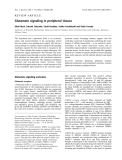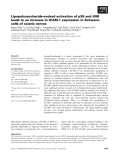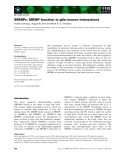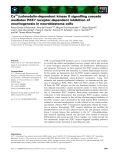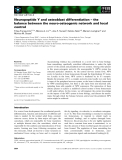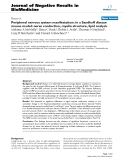
Peripheral nervous system
-
Theo nghĩa sinh học, mạng nơ-ron là một tập hợp các dây thần kinh kết nối với nhau. Ngày nay, thuật ngữ này còn dùng để chỉ mạng nơ-ron nhân tạo, cấu thành từ các nơ-ron nhân tạo. Do đó thuật ngữ 'mạng nơ-ron' xác định hai khái niệm phân biệt: Mạng nơ-ron sinh học là một mạng lưới (plexus) các nơ-ron có kết nối hoặc có liên quan về mặt chức năng trực thuộc hệ thần kinh ngoại biên (peripheral nervous system) hay hệ thần kinh trung ương (central nervous system). Trong ngành thần kinh học...
 13p
13p  and_12
and_12
 08-08-2013
08-08-2013
 86
86
 10
10
 Download
Download
-
The hypothesis thatL-glutamate (Glu) is an excitatory amino acid neurotransmitter in the mammalian central nervous system is now gaining more support after the suc-cessful cloning of a number of genes coding for the signaling machinery required for this neurocrine at synapses in the brain. These include Glu receptors (signal detection), Glu transporters (signal termination) and vesicular Glu trans-porters (signal output through exocytotic release).
 13p
13p  dell39
dell39
 03-04-2013
03-04-2013
 64
64
 4
4
 Download
Download
-
Lipopolysaccharide is a major constituent of the outer membrane of Gram-negative bacteria. It activates monocytes and macrophages to produce cytokines such as tumor necrosis factor-aand interleukins IL-1b and IL-6. These cytokines appear to be responsible for the neurotoxicity observed in peripheral nervous system inflammatory disease.
 11p
11p  galaxyss3
galaxyss3
 07-03-2013
07-03-2013
 35
35
 4
4
 Download
Download
-
The mammalian nervous system is relatively autonomous in lipid metabolism. In particular, Schwann cells in the peripheral nervous system, and oligodendrocytes and astrocytes in the central nervous system, are highly active in lipid synthesis.
 9p
9p  vinaphone15
vinaphone15
 27-02-2013
27-02-2013
 45
45
 3
3
 Download
Download
-
ATP, via purinergic P2X receptors, acts as a neurotransmitter and modula-tor in both the central and peripheral nervous systems, and is also involved in many biological processes, including cell proliferation, differentiation and apoptosis. Previously, we have reported that P2X7 receptor inhibition promotes axonal growth and branching in cultured hippocampal neurons.
 19p
19p  vinaphone15
vinaphone15
 25-02-2013
25-02-2013
 42
42
 3
3
 Download
Download
-
Accumulating evidence has contributed to a novel view in bone biology: bone remodeling, specifically osteoblast differentiation, is under the tight control of the central and peripheral nervous systems. Among other players in this neuro-osteogenic network, the neuropeptide Y (NPY) system has attracted particular attention.
 11p
11p  viettel02
viettel02
 19-02-2013
19-02-2013
 40
40
 3
3
 Download
Download
-
Tuyển tập báo cáo các nghiên cứu khoa học quốc tế ngành y học dành cho các bạn tham khảo đề tài: Peripheral nervous system manifestations in a Sandhoff disease mouse model: nerve conduction, myelin structure, lipid analysis
 9p
9p  panasonic01
panasonic01
 13-12-2011
13-12-2011
 53
53
 4
4
 Download
Download
-
Abstract Glucose homeostasis in humans is an important factor for the functioning of nervous system. Hypoglycemia and hyperglycemia is found to be associated with central and peripheral nerve system dysfunction. Changes in acetylcholine receptors have been implicated in the pathophysiology of many major diseases of the central nervous system (CNS). In the present study we showed the effects of insulin induced hypoglycemia and streptozotocin induced diabetes on the cerebellar cholinergic receptors, GLUT3 and muscle cholinergic activity. Results showed enhanced binding parameters and gene...
 9p
9p  toshiba23
toshiba23
 18-11-2011
18-11-2011
 54
54
 2
2
 Download
Download
-
Neurogenic shock is shock caused by the sudden loss of the autonomic nervous system signals to the smooth muscle in vessel walls. This can result from severe central nervous system (brain and spinal cord) damage. With the sudden loss of background sympathetic stimulation, the vessels suddenly relax resulting in a sudden decrease in peripheral vascular resistance (vasodilatation) and decreased blood pressure.
 4p
4p  truongthiuyen1
truongthiuyen1
 09-06-2011
09-06-2011
 62
62
 3
3
 Download
Download
CHỦ ĐỀ BẠN MUỐN TÌM









